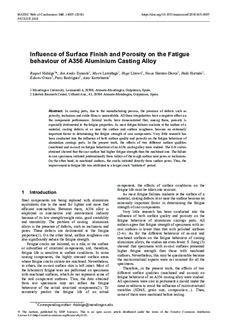| dc.rights.license | Attribution 4.0 International | * |
| dc.contributor.author | Hidalgo, Raquel | |
| dc.contributor.author | Esnaola, Jon Ander | |
| dc.contributor.author | Llavori, Inigo | |
| dc.contributor.author | Larrañaga, Miren | |
| dc.contributor.author | Herrero-Dorca, Nuria | |
| dc.contributor.author | Hurtado, Iñaki | |
| dc.contributor.author | Kortabarria, Aitor | |
| dc.contributor.other | Rodríguez, P. | |
| dc.contributor.other | Ochoa de Zabalegui Pereda, Edurne | |
| dc.date.accessioned | 2019-11-12T15:39:40Z | |
| dc.date.available | 2019-11-12T15:39:40Z | |
| dc.date.issued | 2018 | |
| dc.identifier.other | https://katalogoa.mondragon.edu/janium-bin/janium_login_opac.pl?find&ficha_no=147817 | en |
| dc.identifier.uri | https://hdl.handle.net/20.500.11984/1497 | |
| dc.description.abstract | In casting parts, due to the manufacturing process, the presence of defects such as porosity, inclusions and oxide films is unavoidable. All these irregularities have a negative effect on the component performance. Several works have demonstrated that, among them, porosity is especially detrimental to the fatigue properties. As most fatigue failures nucleate at the surface of a material, casting defects at or near the surface and surface roughness become an extremely important factor in determining the fatigue strength of cast components.Very little research has been conducted into the influence of both surface quality and porosity on the fatigue behaviour of aluminium castings parts. In the present work, the effects of two different surface qualities (machined and as-cast) on fatigue behaviour of an A356 casting alloy were studied. The S-N curves obtained showed that the cast surface had higher fatigue strength than the machined one. The failure in cast specimens initiated predominantly from valleys of the rough surface near pores or inclusions. On the other hand, in machined surfaces, the cracks initiated directly from surface pores. Thus, the improvement in fatigue life was attributed to a longer crack “initiation” period. | en |
| dc.description.sponsorship | Gobierno de España | es |
| dc.language.iso | eng | en |
| dc.publisher | EDP Sciences | en |
| dc.rights | © Los autores | en |
| dc.rights.uri | http://creativecommons.org/licenses/by/4.0/ | * |
| dc.title | Influence of Surface Finish and Porosity on the Fatigue behaviour of A356 Aluminium Casting Alloy | en |
| dcterms.accessRights | http://purl.org/coar/access_right/c_abf2 | en |
| dcterms.source | MATEC Web Conference. 12th International Fatigue Congress (FATIGUE 2018) | en |
| local.contributor.group | Diseño y mecánica estructural | es |
| local.description.peerreviewed | true | en |
| local.relation.projectID | GE/Retos-Colaboración del Programa Estatal de Investigación, Desarrollo e Innovación Orientada a los Retos de la Sociedad, en el marco del Plan Estatal de Investigación Científica y Técnica y de Innovación 2013-2016/RTC-2015-3822-4/Desarrollo de aleaciones de aluminio de altas prestaciones para diseño y fabricación de componentes de automoción aligerados mediante tecnología BP/ALPRE | en |
| local.contributor.otherinstitution | Edertek S. Coop. | es |
| local.source.details | Vol.165. 14007. EDP Sciences, 2018 | eu_ES |
| oaire.format.mimetype | application/pdf | |
| oaire.file | $DSPACE\assetstore | |
| oaire.resourceType | http://purl.org/coar/resource_type/c_c94f | en |
| oaire.version | http://purl.org/coar/version/c_970fb48d4fbd8a85 | en |








